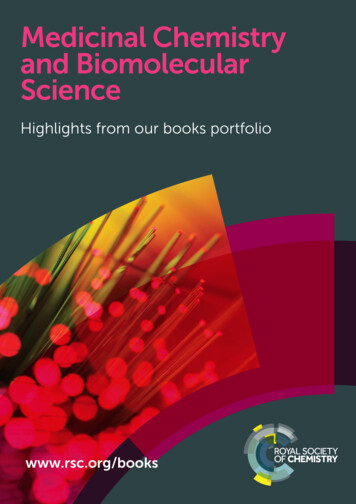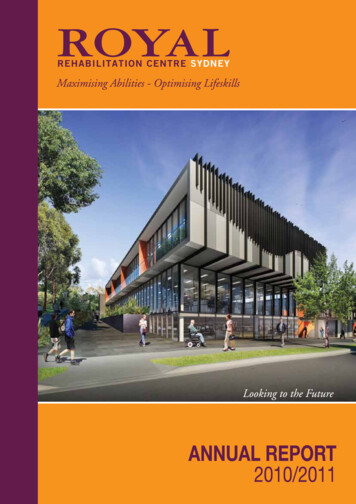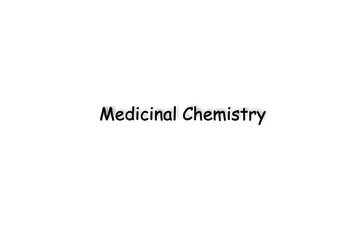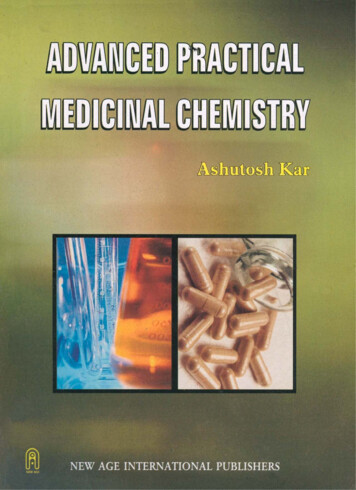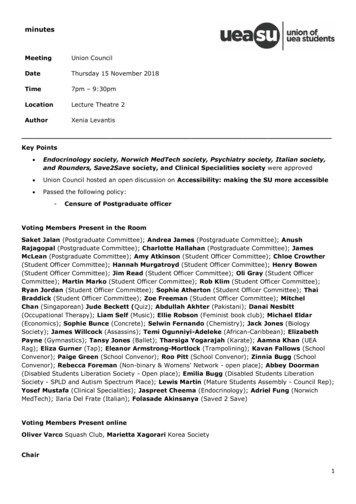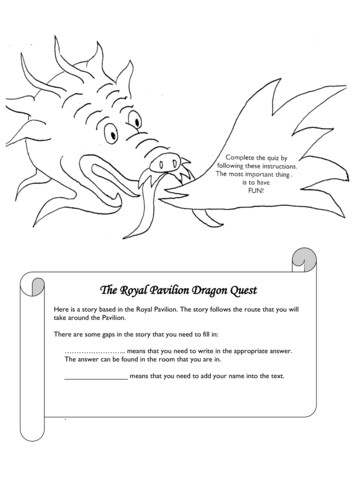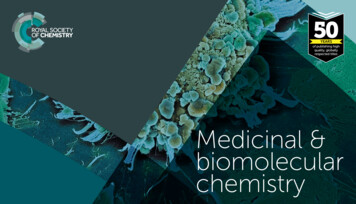
Transcription
YEARSof publishing highquality, globallyrespected titlesMedicinal &biomolecularchemistry
New booksfrom the Royal Society of ChemistryAs we celebrate our Golden anniversary, 50 years since the first book in ourSpecialist Periodical Reports series was published, our publishing programme isthriving as we continue to support scientists, researchers, students and teachers.And don’t forget all the new developments marking exciting beginnings: newEditorial Board members, first books in some series and fresh series underdiscussion.With titles spanning the breadth of the chemical sciences, covering the coredisciplines and their related fields as well as emerging topics, we are building alegacy of high quality, internationally respected books with contributions from allover the world.If you have any queries, contact books@rsc.org to talk to the team.So much to celebrateHappy reading203060255070For a list of books published prior to 2018, visit rsc.li/backlisttitles now make up NewDevelopments in NMRbooks have now been published inMonographs in Supramolecular Chemistrybooks now fill ourGreen Chemistry seriesRoheena Anand Publisher, BooksSara Bowler Books Product and Sales Manageryears since the first book published in Issues inEnvironmental Science and Technologytitles now belong in our Nanoscience andNanotechnology seriestitles enrich ourDrug Discovery seriesRoyal Society of Chemistry Thomas Graham HouseScience Park Milton Road Cambridge CB4 0WF UKTel 44 (0)1223 420066 Fax 44 (0)1223 426017Royal Society of Chemistry Books rsc.li/books1
Ways to buyDigital optionsThe complete eBook collection is over1,550 titles, and can be broken down asfollows:By yearBuild on your existing collection byadding the eBooks published in aspecific year.Placing your orderPrint optionsBuild up your collection by speciallycurated book series.Librarians and organisationsIndividualsTo place an order for printbooks please contact yourpreferred library supplier or findour regional representatives anddistributors on pageVisit our online bookshopTo find out more about oureBook options visit our websiteor torequest prices contact our salesteam sales@rsc.orgOr call 44 (0) 1223 432496Smaller collections sorted by subject areaor by theme.By subjectThese smaller sets focus on eight primarytopic areas within the chemical sciences.Purchase any book from the collectionon its own.Pick and ChooseSelect only the titles you need from thecomplete collection.VisitPart of our eBook collectionAll prices correct at the time of printingRoyal Society of Chemistry Books rsc.li/booksAvailable as an eBook from selected online booksellers2
This year’s portfolio sees us further expanding our chemical biology, drugdiscovery, metallobiology, toxicology and photoscience series. Exciting new titlesjoin a portfolio already full of high quality research from some of the leading mindsin the field.Five minutes with.Name Nathan BrownAffiliation Benevolent AI, London, UKEditor of Artificial Intelligence in DrugDiscoveryBook publication date February 2019ISBN 9781788015479Tell us about your bookWhile the fields of AI and Drug Discovery have had significant overlap for manyyears, there has been renewed and concerted efforts to combine the strengthsof both to make significant leaps forward. This book will cover the history andfundamentals of artificial intelligence and machine learning, with case studiesfrom the literature that demonstrate their potential and their impact in the field.The book will then look at the wealth of chemistry data and the potential to learnfrom these data, before moving straight into predictive modelling and its impactin molecular design. These methods take advantage of both chemical and proteinstructural data to make better predictions and designs. The later sections of thebook cover synthesis planning, in my opinion the holy grail of computationalchemistry methods, and using AI in molecular simulations.Which drug that has been discovered do you feel has had the most impact? e.g.improving people’s lives?Having been involved in many drug discovery projects myself that have reachedthe clinic, I am acutely aware of the contributions that these efforts from largeteams make. I once met V. Craig Jordan, who discussed his work on Tamoxifen inthe 1970s. His research led to improving the health of millions of women, and isestimated to have saved the lives of 500,000. It is astounding to think that relativelysmall groups of people can have such a positive impact on society.How did you get into your field?I had a somewhat atypical route into Chemoinformatics, but was fundamentallyinterdisciplinary before this was really a thing. I started out as a Computer Scientist,working on artificial life simulations, which got me interested in a certain class ofevolutionary algorithms to optimise solutions using analogues of natural evolution.This research led me onto a PhD applying these algorithms to challenges indrug discovery. I found this research incredibly interesting and I could clearly seepotential benefits to humanity. Roll on twenty years and I am now leading a teamof Chemoinformatics Data Scientists working on challenges in Drug Discoveryusing Artificial Intelligence.Part of our eBook collectionAvailable as an eBook from selected online booksellersRoyal Society of Chemistry 2018 books medicinal & biomolecular rsc.li/medicinal-books-183
Five minutes with.Name Angela CasiniAffiliation Cardiff University, UKCo-editor of Metal-based Anticancer AgentsBook publication date February 2019ISBN 9781788014069Tell us about your bookWithin the RSC Metallobiology book series, “Metal-based Anticancer Agents”aims to emphasise the most significant experimental and conceptual progressesmade during the last few years in the areas of inorganic medicinal chemistryand metallodrug discovery and development with a focus on cancer therapy.The content of the book is arranged according to (i) Main classes of anticancermetallodrugs, (ii) emerging concepts in metallodrugs discovery, (iii) methoddevelopment and (iv) preclinical and clinical development. The book coversmuch of the vast spectrum of inorganic drug discovery and development, fromsynthetic approaches and novel supramolecular scaffolds to clinical evaluations.It’s a unique overview of this exciting and highly interdisciplinary area of researchand provides an overview/update of the pre-clinical and clinical evaluation of novelmetal-based anticancer agents. It would be a valuable resource for experts, butalso for people new to the field.Royal Society of Chemistry Books rsc.li/booksWhat do you think will be the next big breakthrough in your subject area?I am particularly intrigued by the new examples of metal-basedradiopharmaceutical as ‘ theranostic’ agents for both therapy and imaging ofcancer. The field of supramolecular coordination complexes for biomedicalapplications is still in its infancy, but the latest examples hold promise for futureadvancements in drug discovery, as well as for the development of novelanticancer drug delivery systems.You were listed as one of the world’s most influential scientific minds of 2014 inpharmacology by Thomson Reuters, who would you say has been the biggestinfluence during your career?The chance to collaborate over the years with colleagues from different areasin the drug discovery field, from chemistry, chemical biology, pharmacologyand medicine. Instrumental to my academic career has been my participationin several EU COST (European Cooperation in Science and Technology)Actions. COST Actions are bottom-up science and technology networks, opento researchers and stakeholders with a duration of four years. They are activethrough a range of networking tools, such as workshops, conferences, trainingschools, short-term scientific missions (STSMs), and dissemination activities. TheseActions are invaluable for early carer researchers to build up their internationalnetwork of collaborations so as to achieve academic independence. Severalof the contributors to my book (including the two co-editors) were also COSTparticipants I met over the years.What was the biggest challenge you faced when writing your book?I did not write the entire book myself, so a challenge was to inspire thecontributors to provide not only a chemistry perspective, but to combine it with atranslational point of view in each chapter. So far the various authors have done agreat job, and it was a real pleasure working with them on this volume.4
About the seriesISSN: 2055-1975NMR in Chemical BiologyAdvances and ApplicationsEditor-in-chiefTom Brown University of Oxford, UKSofia Pauleta Universidade Nova de Lisboa, Portugal Eurico J CabritaUniversidade Nova de Lisboa, PortugalSeries editorsSabine Flitsch University of Manchester, UK Kira J Weissman Université de Lorraine, France Nick J Westwood University of St Andrews, UKNMR is an important tool for achiving molecular reasoning of biological systemsat the interface between chemistry and biology. NMR in Chemical Biology focuseson the use of small molecules as tools for chemical biology, the latest advances instructure elucidation of small molecules and their interactions with biomolecules,modern approaches to structure determination of lipids, proteins, glycans andnucleic acids as well as the NMR approaches to characterize complex proteindynamics in folustion. Illustrated with examples of the application of NMR totackle important problems in chemical biology, this book is ideal for a wide rangeof chemical biologists from medicinal and organic chemists to biochemists inacademia and industry working in a range of disciplines.The Chemical Biology Series is a new venturethat aims to provide a comprehensive suite ofreference books on developing areas at theinterface of chemistry and biology. Chapterswritten and edited by experts worldwide willintroduce practical aspects and best methods,will explain the fundamental chemistryknowledge, and will provide forward-lookingperspectives. Ultimately, the series aims toaid postgraduate students and researchersapply chemical tools and understand currentchallenges in the field. The books will provide avaluable reference for scientists working outsidetheir own area of current expertise or looking toengage in chemical biology research. Coveragewill include topics such as analytical andcomputational tools, chemical probes, imaging,glycosciences, genomics and transcriptomics,chemical genetics and gene editing tools, andaspects of synthetic biology.Hardback 450 pages 9781788011723 2019 179.00 250.00Synthetic GlycomesPeng George Wang Georgia State University, USA Wanyi Guan Hebei NormalUniversity, China Lei Li Georgia State University, USAGlycans play essential roles in diverse biological and aetiological processes.Developments of the glycan microarray our knowledge of the function of glycanshas increased, however the accessibility of glycans is a major obstacle to furtherstudy. To circumvent this limitation many synthetic strategies including chemical,enzymatic and chemo-enzymatic have been developed to produce libraries ofstructurally defined complex glycans. The objective of this book is to provide acomprehensive review of the current state of the synthetic glycome and introducethe application of synthetic glycomes in the glycan microarray. Syntheticglycomes is an ideal reference for students and chemical biologists interested inthe development of synthetic glycomes and the study of glycans.Hardback 350 pages 9781788011648 2019 169.00 235.00Royal Society of Chemistry Books rsc.li/medicinal-books5
About the seriesCutaneous PhotoagingISSN: 2041-9716Rachel E B Watson University of Manchester, UK Christopher E M GriffithsUniversity of Manchester, UKSeries editorsEvelyne Sage, Institut Curie, France Lesley Rhodes, University of Manchester, UK Massimo Trotta, Istituto per i Processi ChimicoFisici-CNR, ItalyComprehensive Series in Photochemicaland Photobiological SciencesOptogeneticsLight-driven Actuators and Light-emittingSensors in Cell BiologyEdited by Sophie Vriz and Takeaki OzawaInitiated by the European Societyfor Photobiology this series providescomprehensive overviews on specific areas ofphotoscience, giving in-depth coverage of thevery different fields related to light effects. Itembraces both well-established and emergingfields and allows investigators, physicians,industrialists and postgraduate students toobtain an updated account in specific areasand a ready access to the recent literature.Importantly, books in this series provide a criticalevaluation of the directions that the field istaking.Photoaging results from chronic exposure to UV radiation and is an increasinglycommon clinical feature, with an aging population the clinical burden is likelyto increase despite advances in our understanding of the pathology anddevelopment of improved treatments. This book will present and review the latestprogress from the forefront of translational research in cutaneous photoaging.With a global team of authors Cutaneous Photoaging provides an internationalperspective on the causes, consequences, pathophysiology and treatment ofphotoaging, ideal for dermatologists, students and professionals in photoscience.Hardback 350 pages 9781788011266 2019 169.00 235.00Optical Techniques in Biomedical andBiophysical SciencesFranco Fusi Universita degli Studi di Firenze, Italy Giovanni Romano University ofFlorence, ItalyOptical Techniques in Biomedical and Biophysical Sciences aims to providean overview of light sources, together with an extensive and authoritativedescription of the optical techniques in bio-medicine. This book is designed togive biomedical researchers a strong feel for the capability of physical approaches,promote new interdisciplinary interests and persuade more practitioners to takeadvantage of optical techniques. Supplemented with videos providing a hands-ondescription of the techniques and procedures, this book has a technique focusedapproach ideal for anyone working in this interdisciplinary field.Hardback 350 pages 9781788015295 2020 169.00 235.00Royal Society of Chemistry Books rsc.li/medicinal-books6
About the seriesISSN: 2041-3203Editor-in-chiefDavid Thurston King’s College London, UKDrug DiscoveryAdvances in NucleicAcid TherapeuticsEdited by Sudhir Agrawal and Michael J. GaitSeries editorsIan Storer AstraZeneca, UK David Fox VulpineScience and Learning, UK Ana Martinez Centrode Investigaciones Biologicas-CSIC, Spain David Rotella Montclair State University, USA Hong Shen Roche Innovation Center Shanghai,ChinaThe Drug Discovery Series covers all aspectsof drug discovery and medicinal chemistryand contains over sixty books published since2010. Providing comprehensive coverage ofthis important and far-reaching area, the booksencourage learning in a range of differenttopics and provide valuable reference forscientists working outside their own areas ofexpertise. Books feature case studies to bringdifferent aspects of the drug discovery processalive and they detail the fundamental sciencenecessary for understanding through to themost up-to-date discoveries and cutting-edgetechnology. Chapters are written and editedby experienced researchers from both industryand academia. This series will be of particularinterest to postgraduate students and medicinalchemists and biochemists working in academiaor industry.Advances in Nucleic Acid TherapeuticsSudhir Agrawal Idera Pharmaceuticals, USA Michael J Gait MRC Laboratory ofMolecular Biology (LMB), UKThe sequencing of the human genome and subsequent elucidation of themolecular pathways that are important in the pathology of disease have providedunprecedented opportunities for the development of new therapeutics. Nucleicacid-based drugs have emerged in recent years to yield extremely promisingcandidates for drug therapy to a wide range of diseases. Advances in NucleicAcid Therapeutics is a comprehensive review of the latest advances in the field,covering the background of the development of nucleic acids for therapeuticpurposes to the array of drug development approaches currently being pursued.Bringing contributions together from leaders at the forefront of progress, thisbook depicts the many approaches currently being pursued in both academia andindustry.Hardback 600 pages 9781788012096 2019 199.00 275.00Anti-fibrotic Drug DiscoveryJehrod Brenneman KSQ Therapeutics, USA Malliga Iyer National Institutes ofHealth, USAFibrosis is a condition with globally high unmet medical need and as such is ahighly active area of academic and pharmaceutical research covering multipletreatment targets, organs tissues and therapeutic approaches. Anti-Fibrotic DrugDiscovery is a single source reference for the latest drug-discovery approachesto tackle fibrosis in various tissues, comprehensively covering recent success andfuture perspectives on emerging therapeutic intervention points. This book isideal for practitioners in fibrosis drug discovery and research as well as cliniciansspecialising in liver, kidney, heart and lung disease in which fibrosis plays a key rolein pathology.Hardback 450 pages 9781788015103 2020 179.00 250.00Royal Society of Chemistry Books rsc.li/medicinal-books7
Artificial Intelligence in Drug DiscoveryDrug Discovery for Emerging VirusesNathan Brown Benevolent AI, London, UKCésar Muñoz-Fontela Bernhard Nocht Institute for Tropical Medicine, Germany Rafael Delgado Hospital Universitario 12 de Octubre, SpainDue to significant advances in Deep Learning and related areas, artificialintelligence methods are increasingly utilised in drug discovery to tacklechallenges that have hitherto been difficult to solve, such as predicting properties,designing molecules, and optimising synthetic routes. Artificial Intelligence in DrugDiscovery comprehensively covers artificial intelligence and machine learningtools and techniques; covering specific challenges such as learning from chemicaldata, designing new molecular structures, predictive modelling in both ligandand structure-space, synthesis planning, and molecular simulations. The booktackles real-world challenges in drug discovery ensuring context of application ispreserved and disseminated by world leaders in the field.New antivirals are urgently needed. Recent outbreaks caused by viruses with greatepidemiological impact such as Zika, or extraordinary virulence such as Ebola,Nipah, Lassa, Crimean-Congo Haemorrhagic fever highlight the current lack ofclinically proven vaccines and treatments for these potentially catastrophic agents.Drug Discovery for Emerging Viruses will comprehensively outline the state of theart in antiviral drug discovery including identification of targets, screening, strategies,and the current pipeline of candidate antivirals. The book will also address thechallenges faced in proceeding from pre-clinical studies to animal models andclinical trials with these highly pathogenic agents.Hardback 500 pages 9781788015479 2020 179.00 250.00Hardback 340 pages 9781788015646 2020 159.00 220.00Cytotoxic Payloads for Antibody–DrugConjugatesMedicinal Chemistry OptimizationDavid E Thurston King’s College London, UK Paul J M Jackson FemtoGenix Ltd,UKSarah Skerratt Vertex Pharmaceuticals, UK Patrick Schnider Roche SwitzerlandThe antibody–drug conjugates (ADCs) field is one of the fastest growing areas ofdrug discovery and represents a large body of research. ADCs deliver a cytotoxicpayload, a key component of the overall ADC design, specifically to cancer cellsby attaching it to an antibody targeted to antigens on the cell surface. This bookdiscusses the range of payloads used to date along with their advantages anddisadvantages, and describes novel payloads at the research stage that may beused clinically in the near future.Hardback 500 pages 9781788010771 2019 179.00 250.00A Guide to ADMET ChallengesMedicinal chemistry is a complex science that lies at the very heart of drugdiscovery. Poor solubility, complex metabolism, tissue retention and slowelimination are just some of the properties of investigational compounds thatpresent a challenge to the design and conduct of ADMET studies. Medicinalchemistry experience and knowledge relating to how a lead structure wasmodified to solve a specific problem is generally very challenging to retrieve.Presented in a visual and accessible style Medicinal Chemistry Optimizationintends to provide rapid solutions to overcome the universal challenges tooptimizing ADMET.Hardback 350 pages 9781788012270 2019 110.00 150.00Royal Society of Chemistry Books rsc.li/medicinal-books8
MicroRNAs in Diseases and DisordersPeptide TherapeuticsEmerging Therapeutic TargetsStrategy and Tactics for Chemistry, Manufacturing, and ControlsPhilip V Peplow University of Otago, New Zealand Bridget Martinez University ofCalifornia, USA George A Calin University of Texas MD Anderson Cancer Center,USA Aurora E Kerscher East Virginia Medical School, USAVed Srivastava Intarcia Therapeutics, USAMicroRNAs have a distinct role in the development and progression of a varietyof diseases including cancer, neurological disease and metabolic diseaseamongst others. As such, there is considerable interest in the potential utilisationof microRNAs in precision and personalised medicine, by increasing ourunderstanding of the role of microRNA in the pathology of disease it allows anopportunity to identify potential therapeutic targets. With an international team ofauthors this book covers the global perspective from pathology to treatment witha comprehensive review of how drugs can be designed to target microRNAs in avariety of diseases.Hardback 500 pages 9781788013949 2019 179.00 250.00Peptide therapy has become a key strategy of innovative drug development,however one of the potential barriers for approval of novel peptide drugs in theclinic is their deficiencies in clearly defined CMC strategy from the beginning ofthe clinical development plan. Peptide Therapeutics comprehensively outlinesthe critical process parameters for efficient manufacturing processes for thepeptide drug substances and peptide drug products, the key challenges inquality control, emerging analytical tools, aligning chemistry manufacture andcontrol with clinical trials and current regulatory guidelines. This book will bean asset not only as a reference book for peptide researchers engaged in thepharmaceutical manufacturing setting but also a valuable resource to researchand development scientists and graduate students to understand the developmentand manufacturing process of peptide based medicine.Hardback 400 pages 9781788014335 2020 179.00 250.00Precision MedicineJames W A Ritchie Cancer Research UK, UK Wendy Alderton Precision MedicineCatapult, UKAlso referred to as personalised or stratified medicine, precision medicine has thepotential to revolutionise medicine and healthcare through improved diagnoses,rational disease prevention and more effective, efficient treatment based on anunderstanding of genetic, environmental, and lifestyle factors. This book gives anoverview of the importance, challenges and successes of personalised medicinefrom a drug discovery perspective. This is timely due to recent technologicaldevelopments that have led to demonstrable successes, bringing the vision forpersonalised medicine closer to reality.Hardback 350 pages 9781788011402 2019 169.00 235.00Royal Society of Chemistry Books rsc.li/medicinal-books9
Protein-Protein Interaction RegulatorsSiddhartha Roy Bose Institute, India Haian Fu Emory University School ofMedicine, USAMolecular interations, Protein-Protein interactions play a crucial role in regulatingmany cellular functions. In many diseases, abberant forms of these interactionsplay central roles. Thus, they have emerged as critical drug targets. This bookincludes a survey of recent advances in the structural understanding of proteinprotein interactions as well as recent developments in modulator discovery.Hardback 350 pages 9781788011877 2019 169.00 235.00Royal Society of Chemistry Books rsc.li/medicinal-books10
About the seriesISSN: 1757-7179Editor-in-chiefDiana Anderson University of Bradford, UKIssues in ToxicologyBig Data in PredictiveToxicologyEdited by Daniel Neagu andAndrea-Nicole RicharzSeries editorsAlok Dhawan Indian Institute of ToxicologyResearch (CSIR-IITR), India Tim Marrs EdentoxAssociates, UK Michael D. Waters Consultant,Integrated Laboratory Systems (ILS) Inc., USAThe field of toxicological research is continuallyexpanding and diversifying, driven by the needto understand the human and ecological risksof exposure to chemicals and other toxicants.This Series is devoted to coverage of moderntoxicology and assessment of risk. Written byexpert scientists from academia, governmentand industry, each book will serve as a guideto investigations in toxicology, biomedicine,biochemistry, forensics and environmental andpollution sciences.Big Data in Predictive ToxicologyDaniel Neagu University of Bradford, UK Andrea-Nicole Richarz, EuropeanCommission - Joint Research Centre, ItalyThe rate and volume of toxicological data generation is continually growingdue to novel techniques and software. The amplified pace and capacity of datageneration has repercussions for organising and analysing data output. Thisbook discusses these challenges as well as the nature, storage, analysis andinterpretation of toxicological big data. It details how these data are appliedin toxicity prediction, modelling and risk assessment. This title is relevant forresearchers and postgraduates in the fields of computational methods, appliedand physical chemistry, cheminformatics, biological sciences, predictivetoxicology, and safety and hazard assessment.Hardback 300 pages 9781782622987 2019 159.00 220.00Nanoparticle–Protein CoronaBiophysics to BiologyAshutosh Kumar Ahmedabad Univeristy, India Alok Dhawan Indian Institute ofToxicology Research (CSIR-IITR), IndiaAny nanomaterial is always covered by proteins immediately upon contact witha physiological environment, this phenomenon may be the key to understandingmuch of bionanoscience. This formation of the nanoparticle protein coronachanges the behaviour of the nanoparticle and translates to issues in theirtransport and fate in the environment, animals and humans; this however, alsooffers a new route to study protein interactions. Ideal for toxicologists andresearchers in nanoscience, this book provides a detailed understanding of theformation and biological significance of the corona, as well as the impact onbiological assays, exotoxicity studies and proteomics research.Hardback 350 pages 9781788013918 2019 169.00 235.00Royal Society of Chemistry Books rsc.li/medicinal-books11
The Micronucleus Assay in ToxicologySiegfried Knasmüller Medical University of Vienna, Austria Michael FenechCSIRO Food and Nutrition, Australia, HUMN Project Coordinating Group, AustraliaThe micronucleus assay is one of the most widely used method in genetictoxicology and human biomonitoring. This book covers the detection ofselected important genotoxic carcinogens, such as heavy metals, pesticides andradionuclides, using micronucleus assays and details the methods currently usedfor the analyses of different types of cells in studies. It will explains the molecularmechanisms of micronucleus formation, and provides advice on analysis ofdata. This will be a useful resource for postgraduate students and researchers intoxicology, oncology, chemical and environmental safety, DNA damage, nutrition,genetics, nutrigenomics, nutrigenetics and mutation research.Hardback 400 pages 9781788011341 2019 179.00 250.00Royal Society of Chemistry Books rsc.li/medicinal-books12
About the seriesISSN: 2045-547XEditor-in-chiefC David Garner University of Nottingham, UKMetallobiologyDioxygen-dependentHeme EnzymesEdited by Masao Ikeda-Saito and Emma RavenSeries editorsAnthony Wedd University of Melbourne,Australia Julie Kovacs University of Washington,USA Stefano Ciurli Università di Bologna, Italy Hongzhe Sun University of Hong Kong, HongKong Emma Raven University of Leicester, UKThe Metallobiology Series is a collection ofprofessional reference books covering allaspects of the roles of metals in biologicalsystems. The scope includes metalloenzymes,metalloproteins, storage and transport ofmetal ions, bio-organometallic chemistry andinteraction of metal ions with biomolecules.Books in this series provide authoritativeperspectives from international experts andwill be of interest to both academics and thoseworking in industry in a wide range of disciplines,including medicinal chemistry, pharmaceuticalscience, biochemistry, metallomics andinorganic biochemistry.Royal Society of Chemistry Books rsc.li/medicinal-booksMetal-based Anticancer AgentsAngela Casini Cardiff University, UK Anne Vessières Pierre et Marie CurieUniveristy, France Samuel M Meier-Menches University of Vienna, AustriaMetal-based anticancer drugs, notably platinum-based such as cisplatin, have atremendous clinical impact: it is estimated that at least half of all cancer patientsare treated with a platinum-based drug. Metal-based Anticancer Agents introducesthe main classes of metallodrugs, their possible different biological targets, themajor and concepts and methods. The book also provides an overview of themost significant experimental and conceptual progresses made during the lastyears in the areas of inorganic medicinal chemistry and metallodrug discovery anddevelopment. This book will be a valuable resource for experts in the field but alsofor those wishing to extend their expertise to metal-based cancer drugs.Hardback 500 pages
Royal Society of Chemistry Books rsc.li/medicinal-books 5 About the series ISSN: 2055-1975 Editor-in-chief Tom Brown University of Oxford, UK Series editors Sabine Flitsch University of Manchester, UK Kira J Weissman Université de Lorraine, France Nick J Westwood University of St
